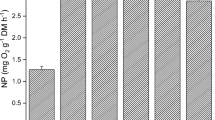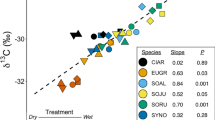Abstract
Bimonthly variations in shoot density, biomass, and blade productivity were used to estimate diel rates of primary productivity in conjunction with in situ measurements of photosynthesis and irradiance for a monospecific meadow ofHalodule wrightii Ascherson in Laguna Madre, Texas. Four separate techniques for estimating areal primary productivity were compared to estimates of primary production calculated from in situ measurements of photosynthesis and continuous recording of underwater light using the Hsat model. The clip and reharvest method, which is commonly used to measure shoot production, provided estimates ranging from 0.003 mol C m−2 d−1 in winter to 0.054 mol C m−2 d−1 in summer. In contrast, a method using aboveground biomass values, previously determined turnover rates, and belowground: aboveground biomass ratios provided estimates of primary production ranging from 0.04 mol C m−2 d−1 (winter) to 0.49 mol C m−2 d−1 (spring), similar to values determined from the Hsat model using in situ measurements of photosynthesis and ambient light regimes. Our results indicate that the clip and reharvest method dramatically underestimates primary productivity forH. wrightii, and that the inclusion of belowground biomass in carbon budget calculations is essential to obtaining realistic estimates of plant productivity. *** DIRECT SUPPORT *** A01BY069 00022
Similar content being viewed by others
Literature Cited
Dawes, C. J., K. Bird, M. Durako, R. Goddard, W. Hoffman, andR. McIntosh. 1979. Chemical fluctuations due to seasonal and cropping effects on an algal-seagrass community.Aquatic Botany 6:79–86.
Dawes, C. J. andM. D. Guiry. 1992. Proximate constituents in the seagrassesZostera marina andZ. noltii in Ireland: Seasonal changes and the effect of blade removal.P.S.Z.N.I. Marine Ecology 13:307–315.
Dawes, C. J. andJ. L. Lawrence. 1979. Effects of blade removal on the proximate composition of the rhizome of the seagrassThalassia testudinum Banks ex König.Aquatic Botany 7:255–266.
Dennsion, W. C. andR. S. Alberte. 1982. Photosynthetic responses ofZostera marina L. (eelgrass) to in situ manipulations of light intensity.Oecologia 55:137–144.
Dunton, K. H. 1990. Production ecology ofRuppia maritima L. s.l. andHalodule wrightii Aschers. in two subtropical estuaries.Journal of Experimental Marine Biology and Ecology 143:147–164.
Dunton, K. H. 1994. An annual quantum budget for the subtropical seagrassHalodule wrightii.Marine Biology 120:479–489.
Dunton, K. H. andD. A. Tomasko. 1994. In situ photosynthetic performance in the seagrassHalodule wrightii in a hypersaline subtropical lagoon.Marine Ecology Progress Series 107: 281–293.
Fourqurean, J. W. andJ. C. Zieman. 1991. Photosynthesis, respiration and whole plant carbon budget of the seagrassThalassia testudinum.Marine Ecology Progress Series 69:161–170.
Hellier, T. R., Jr. 1962. Fish production and biomass studies in relation to photosynthesis in the Laguna Madre of Texas.Publications of the Institute of Marine Science of the University of Texas 8:1–22.
Lapointe, B. E., D. A. Tomasko andW. R. Matzie. 1994. Eutrophication and trophic state classification of seagrass communities in the Florida Keys.Bulletin of Marine Science 54:696–717.
McMahan, C. A. 1969. The food habits of ducks wintering on Laguna Madre, Texas. M.S. Thesis, New Mexico State University, Las Cruces, New Mexico.
Merkord, G. W. 1978. The distribution an abundance of seagrasses in Laguna Madre of Texas. M.S. Thesis, Texas A&I University, Kingsville, Texas.
Morgan, M. D. andC. L. Kitting. 1984. Productivity and utilization of the seagrassHalodule wrightii and its attached epiphytes.Limnology and Oceanography 29:1066–1076.
Odum, H. T. andR. F. Wilson. 1962. Further studies on reaeration and metabolism of Texas bays, 1958–1960.Publications of the Institute of Marine Science of the University of Texas 8:23–55.
Quammen, M. L. andC. P. Onuf. 1993. Laguna Madre: Seagrass changes continue decades after salinity reduction.Estuaries 16:302–310.
SAS Institute. 1985. Procedures Guide. Version 6, Third Edition. SAS Institute, Inc., Cary, North Carolina.
Tomasko, D. A. andC. J. Dawes. 1989a. Effects of partial defoliation on remaining intact leaves in the seagrassThalassia testudinum Banks ex König.Botanica Marina 32:235–240.
Tomasko, D. A. andC. J. Dawes. 1989b. Evidence for physiological integration between shaded and unshaded short shoots ofThalassia testudinum.Marine Ecology Progress Series 54: 299–305.
Tomasko, D. A. andC. J. Dawes. 1990. Influences of season and water depth on the clonal biology of the seagrassThalassia testudinum.Marine Biology 105:345–351.
Tomasko, D. A. andB. E. Lapointe. 1991. Productivity and biomass ofThalassia testudinum as related to water column nutrient availability and epiphyte levels: Field observations and experimental studies.Marine Ecology Progress Series 75:9–17.
Virnstein, R. W. 1982. Leaf growth of the seagrassHalodule wrightii photographically measured in situ.Aquatic Botany 12: 209–218.
Zieman, J. C. 1974. Methods for the study of the growth and production of turtlegrassThalassia testudinum König.Aquaculture 4:139–140.
Zieman, J. C. andR. G. Wetzel. 1980. Productivity in seagrasses: Methods and rates, p. 87–116.In R. C. Phillips and C. P. McRoy (eds.), Handbook of Seagrass Biology: An Ecosystem Perspective. Garland STPM Press, New York.
Zimmerman, R. C., A. Cabello-Pasini, andR. S. Alberte. 1994. Modeling daily carbon gain of aquatic macrophytes from quantum flux measurements: A comparative analysis.Marine Ecology Progress Series 114:185–196.
Author information
Authors and Affiliations
Rights and permissions
About this article
Cite this article
Tomasko, D.A., Dunton, K.H. Primary productivity inHalodule wrightii: A comparison of techniques based on daily carbon budgets. Estuaries 18, 271–278 (1995). https://doi.org/10.2307/1352638
Received:
Accepted:
Issue Date:
DOI: https://doi.org/10.2307/1352638




